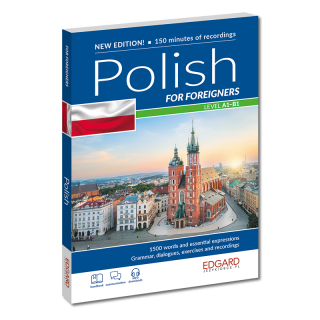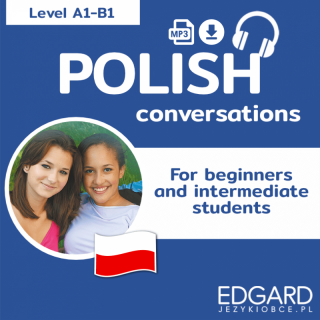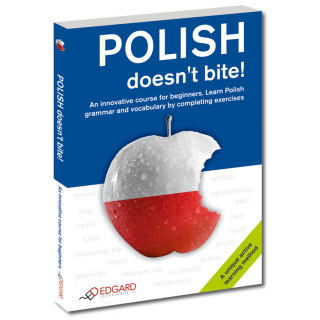- today
- perm_identity Jolanta Krupińska
- label Aktualności
- favorite 0 polubień
- remove_red_eye 196 odwiedzin
- comment 0 komentarzy

Starting to learn Polish but feeling daunted by its reputation as one of the most challenging languages? We’re here to make your journey enjoyable and effective! In this guide, you’ll discover essential Polish vocabulary, learn how to make learning grammar great again, and understand key pronunciation tips to get you started on the right foot.
Contents:
1. Polish – a handful of information
2. Main difficulties when learning Polish
3. Essential Polish vocabulary
4. Hacks to master grammar
5. Pronunciation tips
Polish – a handful of information
Polish is a Slavic language, part of the same language family as Russian, Czech, and Slovak. You have to be cautious though, because one word can mean different things in the mentioned languages. Polish has a rich history and is spoken by approximately 45 million people, mainly in Poland but also among Polish communities worldwide. While Polish might seem intimidating at first, with its complex grammar and challenging pronunciation, it’s also a language with a lot of logical patterns that, once learned, can make it easier to continue progressing.
USEFUL FACTS ABOUT POLISH LANGUAGE
• Alphabet: Polish uses the Latin alphabet, but with additional letters like ą, ć, ę, ł, ń, ó, ś, ź, and ż. These unique characters give the language its distinctive sound.
• Noun cases: Polish is known for its seven grammatical cases, which determine the role of a noun in a sentence. This feature can be tricky for learners but adds precision and richness to the language.
• Loanwords: Due to Poland’s history and interactions with neighboring countries, Polish has borrowed words from languages like German, French, and Italian. For example, the word bilet (ticket) comes from the French billet.
• Pronunciation: Polish pronunciation can be challenging, especially with combinations like sz, cz, and dz. However, once you grasp the rules, reading becomes more straightforward.
• Diminutives: Poles love to use diminutives to express affection or familiarity. For instance, "pies" means "dog," but "piesek" is a cute way to say "puppy."
• Rich literature: Poland has a vibrant literary tradition, with Nobel Prize-winning authors like Wisława Szymborska and Czesław Miłosz contributing significantly to world literature.
• Cultural significance: Learning Polish opens the door to understanding Poland’s rich cultural heritage, including its music, art, and traditions that have influenced the world.
POLISH AROUND THE WORLD
• Many celebrities have Polish roots, for example, Scarlett Johansson, Angelina Jolie, Natalie Portman, Lisa Kudrow, and Emily Ratajkowski have Polish ancestry.
• Some actors can even speak fluent Polish! Check out Paul Wesley or Australian actress Yvonne Strahanovski .
• Polish culture and history have left a significant mark on Brazilian society, evident in the use of the Polish language in public life. In 13 municipalities across Brazil, with Áurea, a municipality in the state of Rio Grande do Sul, Polish serves as a co-official language alongside Portuguese.
Main difficulties when learning Polish
Polish is considered one of the most difficult languages to learn. The most challenging issues when learning Polish may be:
1. Grammar and Cases
The main characteristics of Slavic languages is the fact that the main parts of speech such as verbs, nouns, adjectives, pronouns and numerals are inflected. Polish has a grammatical system based on cases, meaning that nouns, adjectives, pronouns, and numerals change their forms depending on the role they play in a sentence. There are seven cases (e.g., nominative, genitive, dative, accusative, instrumental, locative, and vocative), which can be overwhelming for people learning languages that don’t have such a structure (e.g., English).
For example, the word pies (dog) changes form in different cases:
• Nominative (subject): pies
• Genitive (possession): psa
• Dative (indirect object): psu
• Accusative (direct object): psa
• Instrumental (means or accompaniment): psem
• Locative (location): psie
• Vocative (addressing): psie
This system allows for flexible word order in sentences, as the role of each word is indicated by its case ending rather than its position.
2. Noun gender
In Polish, every noun has a gender: masculine, feminine, or neuter. Using the correct grammatical forms depends on the gender of the noun, which can be tricky, especially because in many cases, the gender isn’t easy to predict (e.g., dziecko (child) – neuter, kobieta (woman) – feminine, mężczyzna (man) – masculine). Additionally, each case has different forms depending on gender.
3. Verbs and conjugation
Verbs in Polish are conjugated by person, number, and tense (e.g., present, past, future).
There are also many irregular verbs (e.g. verb być (to be)), which change in ways that aren’t always intuitive for learners (jestem (I am); jesteś (you are), jest (he / she / it is); byłam (I was – feminine); byłem – I was - masculine)).
Moreover, verb aspects (perfective and imperfective) are another challenge, as they determine whether an action is completed or ongoing (zrobić (do / make - completed) vs. robić (do / make - ongoing)).
4. Pronunciation
Polish pronunciation can be difficult, especially for those unfamiliar with Slavic languages. The language has consonant clusters and sounds that are rare in other languages, such as ś, ć, ź, ż, cz, and sz. Sometimes, the combination of consonants at the beginning or end of words can be hard to pronounce, as in the tongue-twister w Szczebrzeszynie.
5. Stress
Polish has a fixed stress pattern where the accent typically falls on the penultimate syllable (the second-to-last syllable). This can be confusing for learners used to languages where stress is more flexible, like in English.
6. Lack of articles
Unlike many other languages, Polish does not use articles (like the in English or le in French). This can be tricky because learners have to rely entirely on context and grammar to determine whether a noun is definite or indefinite.
7. Vocabulary and idioms
Polish is rich in idiomatic expressions and phrases that don’t have direct translations in other languages. Learning these requires immersion in the language and culture, which can be challenging without regular exposure to native speakers. One words may have many meangs, e.g rozerwać się may mean tear itself (koszula się rozerwała - the shirt has torn) or have fun (chodźmy się rozerwać – let’s have fun)).
Essential Polish vocabulary
It’s always beneficial to learn a few essential words and phrases before traveling to a foreign country. The expressions presented below are not only practical for travelers but also serve as an excellent starting point for those beginning to learn Polish. Discover this linguistic "first aid kit" to help you navigate basic interactions during your travels.
Essential Polish phrases for travelers with pronunciation
| English word / phrase | Translation into Polish | Pronunciation |
|---|---|---|
| hello | cześć | (cheshch) |
| good morning | dzień dobry | (dzien-doh-bri) |
| good evening | dobry wieczór | (dob-rih vyeh-choor) |
| good night | dobranoc | (doh-brah-nots) |
| please | proszę | (pro-sheh) |
| thank you | dziękuję | (djen-koo-yeh) |
| no | nie | (nyeh) |
| excuse me / I’m sorry | przepraszam | (psheh-prah-sham) |
| It’s all right. | Nic nie szkodzi. | (neets nyeh shko-jee) |
| never mind | nie ma za co | (nyeh mah zah tsoh) |
| Thank you! | Dziękuję! | (djen-koo-yeh) |
| You’re welcome. | Nie ma za co | (nyeh mah zah tsoh) |
| Enjoy your meal! | Smacznego! | (smatch-neh-goh) |
| Have a nice weekend! | Miłego weekendu! | (mee-LEH-goh vee-KEN-doo) |
| Thank you, the same to you. | Dziękuję, nawzajem. | (djen-koo-yeh, nahv-ZAI-yem) |
| Excuse me, can you repeat that? | Przepraszam, czy może pan powtórzyć? | (psheh-prah-sham, chi moh-zheh pan poh-TOOR-zhić) |
| goodbye | do widzenia | (doh veed-ZEN-yah) |
| How are you? | Jak się masz? | (yak shyeh mahsh) |
| I don’t speak Polish well. | Nie mówię dobrze po polsku | (nyeh moo-vyeh DOH-bzheh poh POL-skoo) |
| Can you help me? | Czy możesz mi pomóc? | (chi MO-zheh mee poh-moots) |
| Where is the bathroom? | Gdzie jest toaleta? | (gdjeh yest toh-ah-LEH-tah) |
| How much does this cost? | Ile to kosztuje? | (EE-leh toh koh-SH-too-yeh) |
| I don’t understand. | Nie rozumiem. | (nyeh roh-ZOO-myem) |
Hacks to master Polish grammar
Polish, although it may seem complicated, can be mastered by delving into its endings and understanding its grammatical rules. How to achieve this?
• Choose comprehensive resources: Select books that present complex rules in a clear and transparent manner.
• Study grammar in manageable segments: Following the principle that it’s better to do a little than nothing at all, study grammar in small sections. This approach prevents overwhelm and allows for better retention
• Practice consistently: Regular practice is key to mastering Polish grammar
• Learn grammar in a communicative context from the start: Introduce and practice grammatical rules through their application in practical communication situations from the very beginning. This method allows for a better understanding of the function of each structure and its practical use.
• Seek out regularities: Identifying patterns within the language can simplify learning. Recognizing the endings associated with different cases in Polish can aid in understanding sentence structure.
Pronunciation tips
Don’t worry about your pronunciation; it will improve with practice. Try to listen carefully to what’s being said around you when visiting Poland and repeat after native Polish speakers. You can also choose books and other materials that feature recordings by native speakers at a comfortable pace.
Check how to pronunce basic Polsih vowels and consonants:
• ś ([ɕ]) – a soft ‘s’, similar to ‘sh’ in ‘she’
• ź ([ʑ]) – a soft ‘z’, similar to ‘s’ in ‘measure’
• ć ([tɕ]) – pronounced like ‘ch’ in ‘cheese’
• dź ([dʑ]) – a soft ‘dz’, similar to ‘j’ in ‘juice’
• ń ([ɲ]) – a soft ‘n’, similar to ‘ni’ in ‘onion’
Nasal vowels:
• ą ([ɔ̃]) – pronounced as nasal ‘a’, similar to ‘on’ in French
• ę ([ɛ̃]) – pronounced as nasal ‘e’, similar to ‘en’ in French
Pronunciation of nasal vowels based on preceding consonants:
• before w, f, z, s, ż, sz, ź, c, ch:
◦ ą ([ɔ̃]) – as in wąsy ([ˈwɔ̃sɨ]) – ‘moustache’
◦ ę ([ɛ̃]) – as in wąż ([vɔ̃ʐ]) – ‘snake’
• before l, ł:
◦ ą ([ɔ̃]) – as in wziął ([vʑɔ̃w]) – ‘he took’
◦ ę ([ɛ̃]) – as in objął ([ɔbʑɔ̃w]) – ‘he embraced’
• before p, b:
◦ ą ([ɔ̃]) – as in gołąbki ([ɡɔw̃bki]) – ‘dumplings’
◦ ę ([ɛ̃]) – as in zęby ([zɛ̃bɨ]) – ‘teeth’
• before other consonants:
◦ ą ([ɔ̃]) – as in obowiązki ([ɔbɔvʲɔ̃zki]) – ‘duties’
◦ ę ([ɛ̃]) – as in pięć ([pʲɛ̃tɕ]) – ‘five’
Consonants:
• c ([t͡s]) – as in cebula ([t͡sɛbula]) – ‘onion’
• ć ([tɕ]) – as in ciocia ([tɕɔt͡ɕa]) – ‘aunt’
• cz ([t͡ʂ]) – as in czekolada ([t͡ʂɛkɔˈlada]) – ‘chocolate’
• dz ([d͡z]) – as in dzwon ([d͡zvɔn]) – ‘bell’
• dż ([d͡ʐ]) – as in dżungla ([d͡ʐuŋɡla]) – ‘jungle’
• g ([ɡ]) – as in gołąbki ([ɡɔw̃bki]) – ‘dumplings’
• h/ch ([x]) – as in hotel ([ˈxɔtɛl]) – ‘hotel’
• j ([j]) – as in jajko ([ˈjajkɔ]) – ‘egg’
• ł ([w]) – as in ławka ([wafka]) – ‘bench’
• ń ([ɲ]) – as in koń ([kɔɲ]) – ‘horse’
• ó ([u]) – as in truskawka ([truskafka]) – ‘strawberry’
• ś ([ɕ]) – as in środa ([ɕrɔda]) – ‘Wednesday’
• sz ([ʂ]) – as in szkoła ([ʂkɔwa]) – ‘school’
• rz/ż ([ʐ]) – as in rzeka ([ʐɛka]) – ‘river’
• w ([v]) – as in woda ([ˈvɔda]) – ‘water’
• y ([ɨ]) – as in wysoki ([vɨˈsɔkʲi]) – ‘tall’
• ź ([ʑ]) – as in źle ([ʑlɛ]) – ‘badly’
Read also:





Komentarze (0)